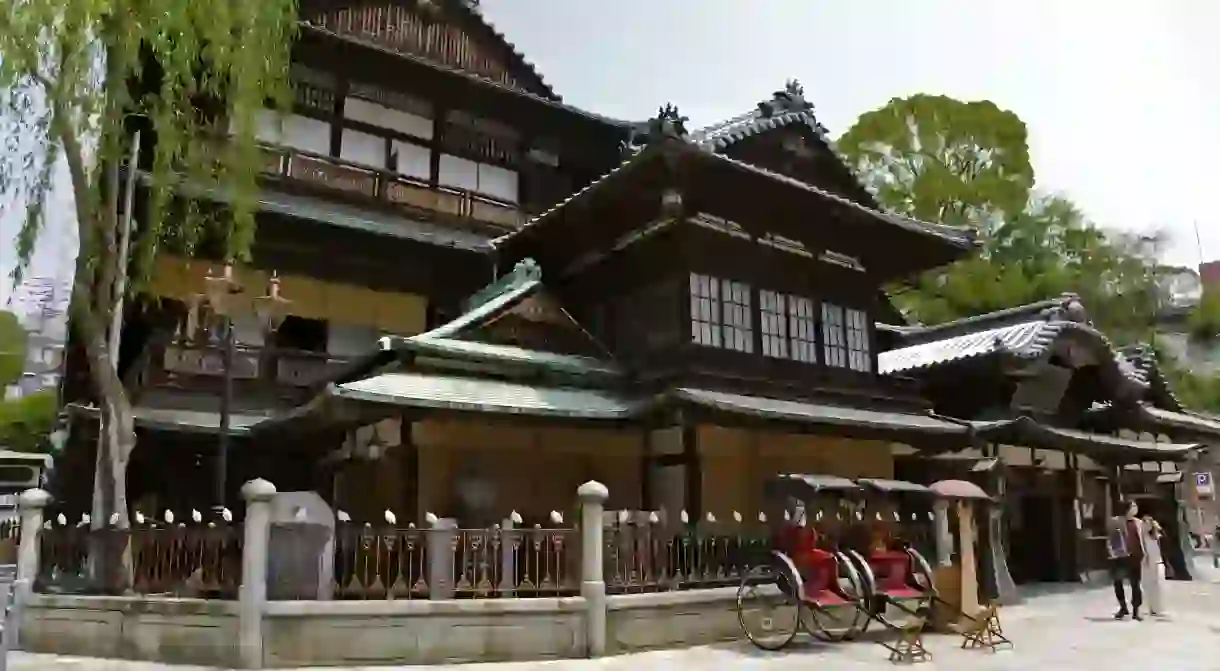A Wellness Guide to Matsuyama’s Onsens

Curiously, Shikoku is the only one of Japan’s four main islands that doesn’t house a volcano. Despite that, though, Shikoku’s capital Matsuyama boasts a buffet of bathhouses that make the most of the island’s mineral-rich hot springs, in particular the must-visit Dogo Onsen Honkan.
Matsuyama Castle might command the skyline, but the city’s onsens dominate the list of reasons to visit Matsuyama. Hey, even the name feels relaxing — Matsuyama literally translates to Pine Mountain in English. North-east of the city centre, Dogo Onsen’s trio of bathhouses are ringed by ryokans and brim with bathers eager to experience one of Japan’s most historic hot springs, first discovered millennia ago. And further afield, Shikoku is peppered with resorts that make wellness warriors weak at the knees. So slip into a yukata, pour the green tea and dive into this wellness guide to Matsuyama, Japan.
Dogo Onsen
Spa
Dogo Onsen Honkan
Health Spa
For centuries, Dogo Onsen Honkan has been a favourite of the Imperial Family, who’ve made a habit of visiting over the years. One section is even roped off for the Emperor – the Yushinden was first constructed for a royal visit in 1899 – but unless he’s visiting on the same day you are, an extra fee buys a peek at this retreat fit for a king. The Honkan was built in 1894, a wooden Meiji-era marvel made up of tangled passageways for half-nude bathers to navigate. Keep an eye out for the sign asking guests to not climb the stairs naked – being a few steps below a towel-less neighbour is no pretty sight. A seven-year renovation project began in January 2019 to preserve this piece of history, but the baths will remain open throughout, and scaffolding won’t interfere with the onsen’s quaint wooden facade out the front. The Honkan is open every day from 6am to 11pm. The cheapest entry costs ¥420 (£3), but more expensive packages open more doors, such as the tatami snack room and the royal Yushinden.
Asuka no Yu
Natural Feature, Spa
Two blocks west of the Honkan lies the newest of Dogo Onsen’s three bathhouses. Asuka no Yu only opened its doors in 2017 but shares similar timber-framed architecture with the neighbour 123 years its senior. In fact, the design is a throwback to the Asuka Period (538-710), when the hot springs of Dogo Onsen were first recorded. Asuka no Yu features a stone bath on the first floor, as well as al fresco pools protected by wooden panels outside. Upstairs, pay an additional fee to enter the large communal tatami room on the second floor for a cup of tea and a breather between dips. This floor is also where bathers will find private rooms and baths. Open the same hours as the Honkan, entry to Asuka no Yu begins at ¥610 (£4.65).
Tsubaki no Yu
Spa, Health Spa, Natural Feature
Right next door to the Asuka no Yu, this bathhouse’s concrete exterior matches its no-fuss price tag, if not its name – Tsubaki no Yu means Camellia Bath in Japanese. This simple resort was built in 1953 with functional indoor baths separated by gender. It might not match the Honkan’s architectural majesty, but it does share the same water – the baths here fizz with the exact same hot springs as its much more famous neighbour. Entry starts at ¥400 (£3); open 6.30am to 11.00pm.
Okudogo Onsen
Spa, Natural Feature
Another five kilometres (3mi) east of Dogo Onsen, Okudogo is somehow even more serene. This secluded resort is shrouded in mountains, valleys and verdant greenery, best appreciated from the outdoor tubs of the Okudogo Ichiyu-no-mori. This bathhouse is attached to a modern hotel – entry for day guests is ¥550 (£4.20), plus an additional fee for a private room (Japanese or Western-style). And gazing at the peaks through the hazy mist of the alkaline sulphur hot springs is worth every yen.
Elsewhere in Shikoku
Natural Feature, Spa
Dogo Onsen Honkan is Shikoku’s number one wellness destination. But the rest of the island is also sprinkled with hot springs for relaxation-seekers to sniff out. Keep heading past Okudogo Onsen to reach Imabari, roughly 40 kilometres (25mi) north-east of Matsuyama, where six ryokan resorts occupy the tranquil Nibukawa Valley. Onsen aficionados should also make the effort to check out Shionoe, another 130 kilometres (80mi) east. Hugging a river that trickles beneath Mount Asan, Shionoe Onsen is lined with centuries-old resorts that rival Dogo Onsen Honkan for history. Further south, Hotel Riviera Shishikui’s onsen accepts day visitors to its huge pools gazing over the Pacific Ocean, making it one of the island’s most salubrious wellness resorts. The Pacific vistas are equally as impressive from the string of hotel hot springs that line the coast of the Ashizuri Cape in Shikoku’s south-west corner.













